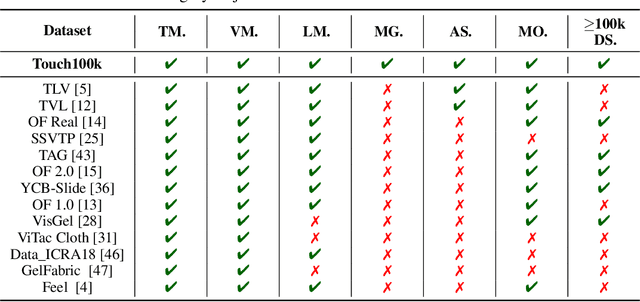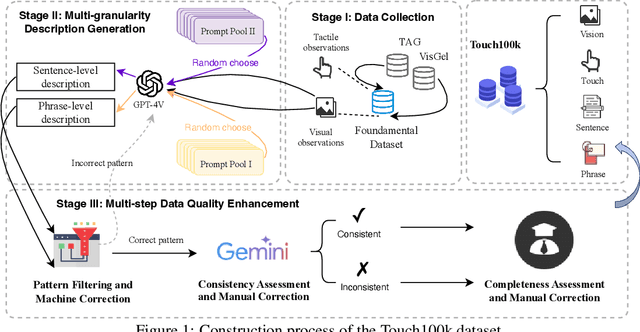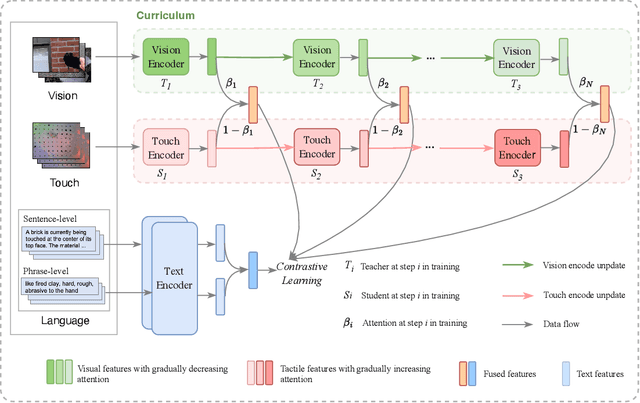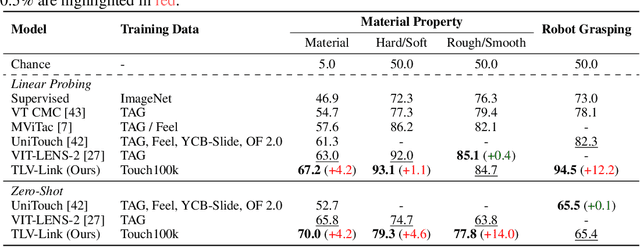Changhao Guan
Touch100k: A Large-Scale Touch-Language-Vision Dataset for Touch-Centric Multimodal Representation
Jun 06, 2024



Abstract:Touch holds a pivotal position in enhancing the perceptual and interactive capabilities of both humans and robots. Despite its significance, current tactile research mainly focuses on visual and tactile modalities, overlooking the language domain. Inspired by this, we construct Touch100k, a paired touch-language-vision dataset at the scale of 100k, featuring tactile sensation descriptions in multiple granularities (i.e., sentence-level natural expressions with rich semantics, including contextual and dynamic relationships, and phrase-level descriptions capturing the key features of tactile sensations). Based on the dataset, we propose a pre-training method, Touch-Language-Vision Representation Learning through Curriculum Linking (TLV-Link, for short), inspired by the concept of curriculum learning. TLV-Link aims to learn a tactile representation for the GelSight sensor and capture the relationship between tactile, language, and visual modalities. We evaluate our representation's performance across two task categories (namely, material property identification and robot grasping prediction), focusing on tactile representation and zero-shot touch understanding. The experimental evaluation showcases the effectiveness of our representation. By enabling TLV-Link to achieve substantial improvements and establish a new state-of-the-art in touch-centric multimodal representation learning, Touch100k demonstrates its value as a valuable resource for research. Project page: https://cocacola-lab.github.io/Touch100k/.
DoRA: Enhancing Parameter-Efficient Fine-Tuning with Dynamic Rank Distribution
May 28, 2024Abstract:Fine-tuning large-scale pre-trained models is inherently a resource-intensive task. While it can enhance the capabilities of the model, it also incurs substantial computational costs, posing challenges to the practical application of downstream tasks. Existing parameter-efficient fine-tuning (PEFT) methods such as Low-Rank Adaptation (LoRA) rely on a bypass framework that ignores the differential parameter budget requirements across weight matrices, which may lead to suboptimal fine-tuning outcomes. To address this issue, we introduce the Dynamic Low-Rank Adaptation (DoRA) method. DoRA decomposes high-rank LoRA layers into structured single-rank components, allowing for dynamic pruning of parameter budget based on their importance to specific tasks during training, which makes the most of the limited parameter budget. Experimental results demonstrate that DoRA can achieve competitive performance compared with LoRA and full model fine-tuning, and outperform various strong baselines with the same storage parameter budget. Our code is available at https://github.com/MIkumikumi0116/DoRA
 Add to Chrome
Add to Chrome Add to Firefox
Add to Firefox Add to Edge
Add to Edge